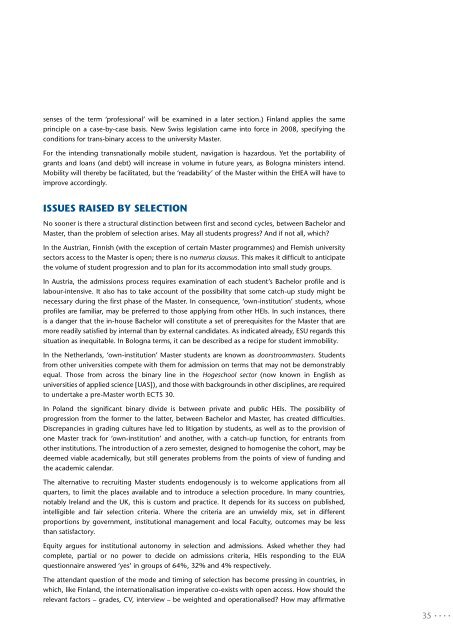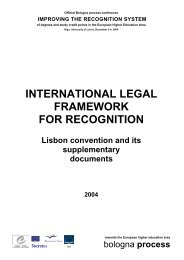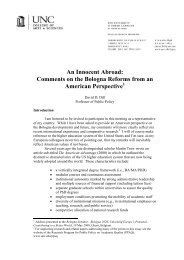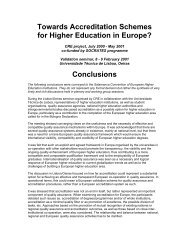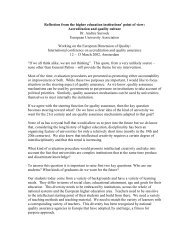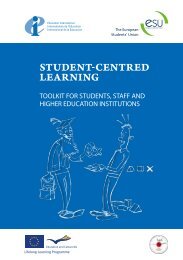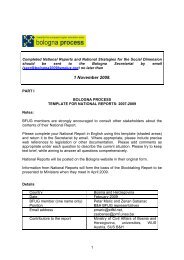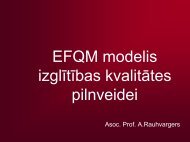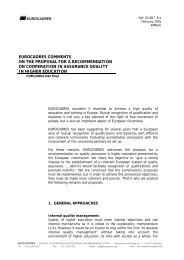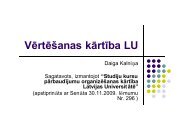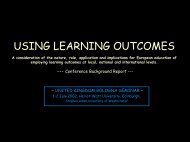EUA Survey Of Master Degrees In Europe - European University ...
EUA Survey Of Master Degrees In Europe - European University ...
EUA Survey Of Master Degrees In Europe - European University ...
Create successful ePaper yourself
Turn your PDF publications into a flip-book with our unique Google optimized e-Paper software.
senses of the term ‘professional’ will be examined in a later section.) Finland applies the sameprinciple on a case-by-case basis. New Swiss legislation came into force in 2008, specifying theconditions for trans-binary access to the university <strong>Master</strong>.For the intending transnationally mobile student, navigation is hazardous. Yet the portability ofgrants and loans (and debt) will increase in volume in future years, as Bologna ministers intend.Mobility will thereby be facilitated, but the ‘readability’ of the <strong>Master</strong> within the EHEA will have toimprove accordingly.Issues raised by selectionNo sooner is there a structural distinction between first and second cycles, between Bachelor and<strong>Master</strong>, than the problem of selection arises. May all students progress? And if not all, which?<strong>In</strong> the Austrian, Finnish (with the exception of certain <strong>Master</strong> programmes) and Flemish universitysectors access to the <strong>Master</strong> is open; there is no numerus clausus. This makes it difficult to anticipatethe volume of student progression and to plan for its accommodation into small study groups.<strong>In</strong> Austria, the admissions process requires examination of each student’s Bachelor profile and islabour-intensive. It also has to take account of the possibility that some catch-up study might benecessary during the first phase of the <strong>Master</strong>. <strong>In</strong> consequence, ‘own-institution’ students, whoseprofiles are familiar, may be preferred to those applying from other HEIs. <strong>In</strong> such instances, thereis a danger that the in-house Bachelor will constitute a set of prerequisites for the <strong>Master</strong> that aremore readily satisfied by internal than by external candidates. As indicated already, ESU regards thissituation as inequitable. <strong>In</strong> Bologna terms, it can be described as a recipe for student immobility.<strong>In</strong> the Netherlands, ‘own-institution’ <strong>Master</strong> students are known as doorstroommasters. Studentsfrom other universities compete with them for admission on terms that may not be demonstrablyequal. Those from across the binary line in the Hogeschool sector (now known in English asuniversities of applied science [UAS]), and those with backgrounds in other disciplines, are requiredto undertake a pre-<strong>Master</strong> worth ECTS 30.<strong>In</strong> Poland the significant binary divide is between private and public HEIs. The possibility ofprogression from the former to the latter, between Bachelor and <strong>Master</strong>, has created difficulties.Discrepancies in grading cultures have led to litigation by students, as well as to the provision ofone <strong>Master</strong> track for ‘own-institution’ and another, with a catch-up function, for entrants fromother institutions. The introduction of a zero semester, designed to homogenise the cohort, may bedeemed viable academically, but still generates problems from the points of view of funding andthe academic calendar.The alternative to recruiting <strong>Master</strong> students endogenously is to welcome applications from allquarters, to limit the places available and to introduce a selection procedure. <strong>In</strong> many countries,notably Ireland and the UK, this is custom and practice. It depends for its success on published,intelligible and fair selection criteria. Where the criteria are an unwieldy mix, set in differentproportions by government, institutional management and local Faculty, outcomes may be lessthan satisfactory.Equity argues for institutional autonomy in selection and admissions. Asked whether they hadcomplete, partial or no power to decide on admissions criteria, HEIs responding to the <strong>EUA</strong>questionnaire answered ‘yes’ in groups of 64%, 32% and 4% respectively.The attendant question of the mode and timing of selection has become pressing in countries, inwhich, like Finland, the internationalisation imperative co-exists with open access. How should therelevant factors – grades, CV, interview – be weighted and operationalised? How may affirmative35


